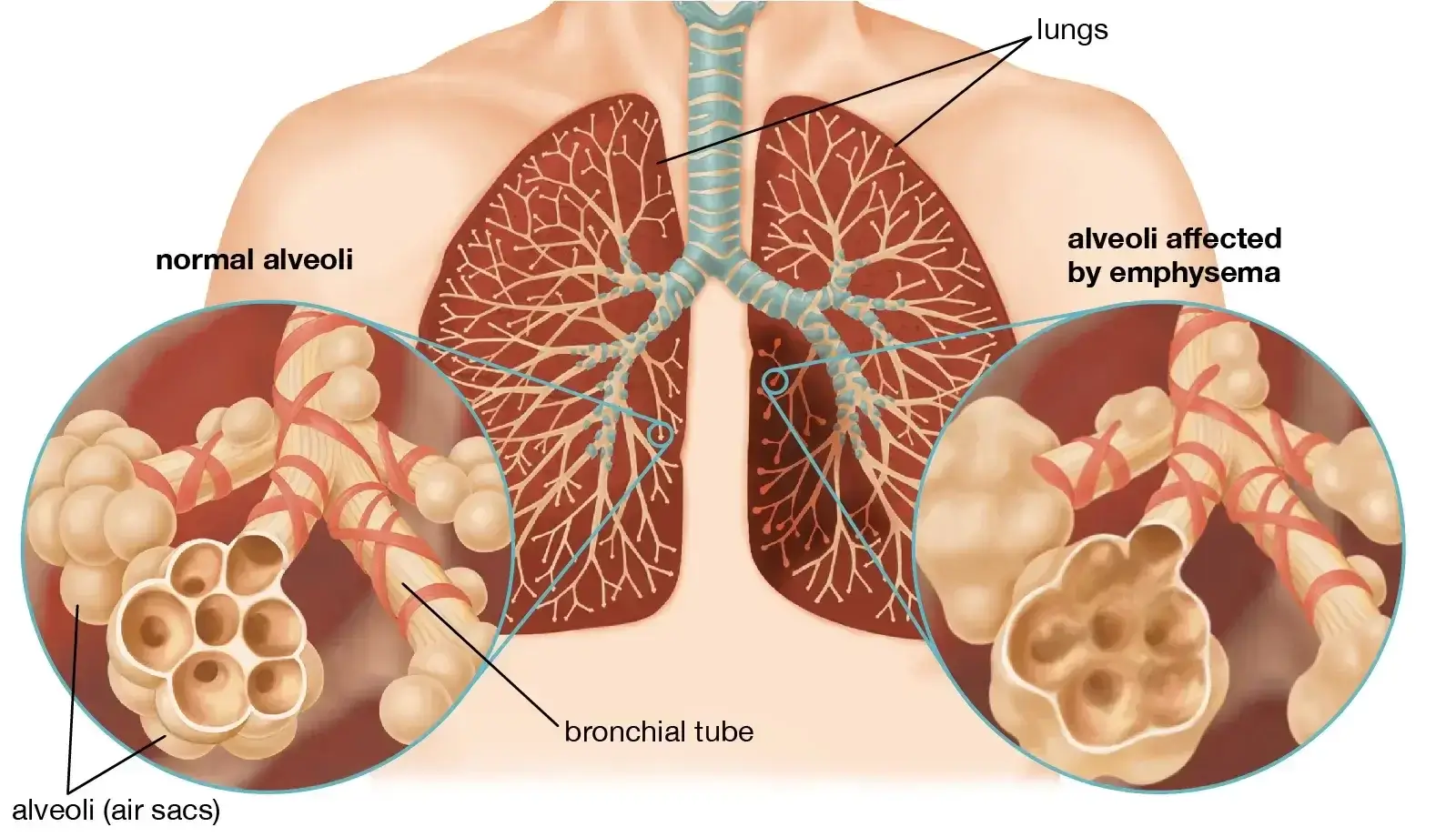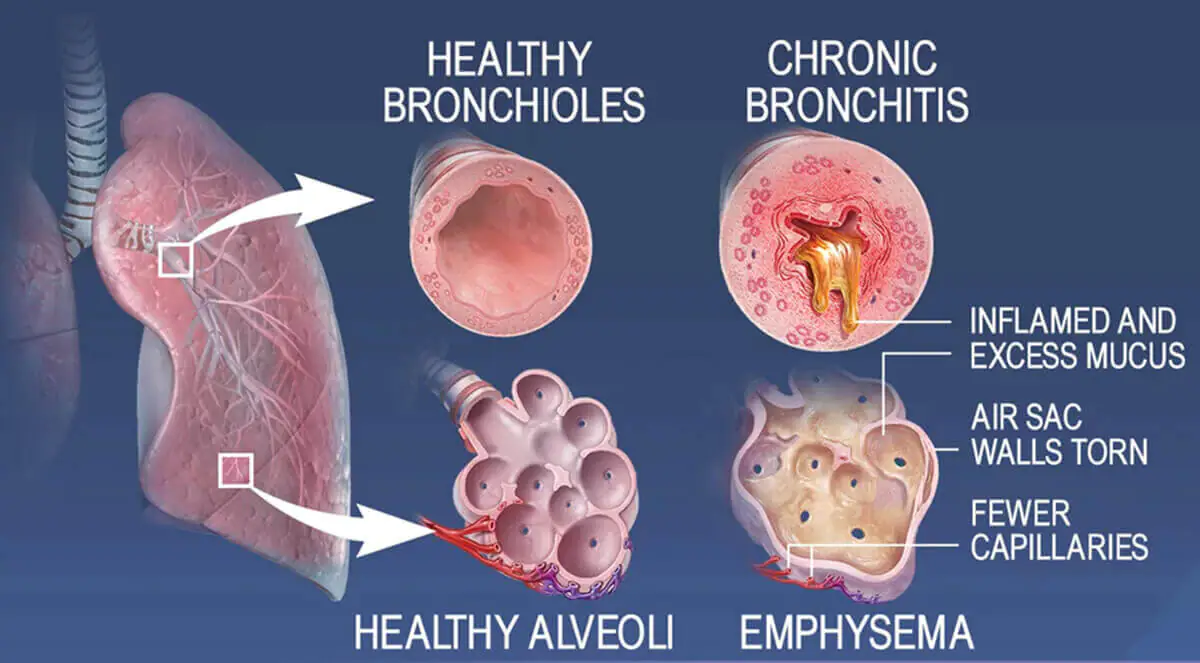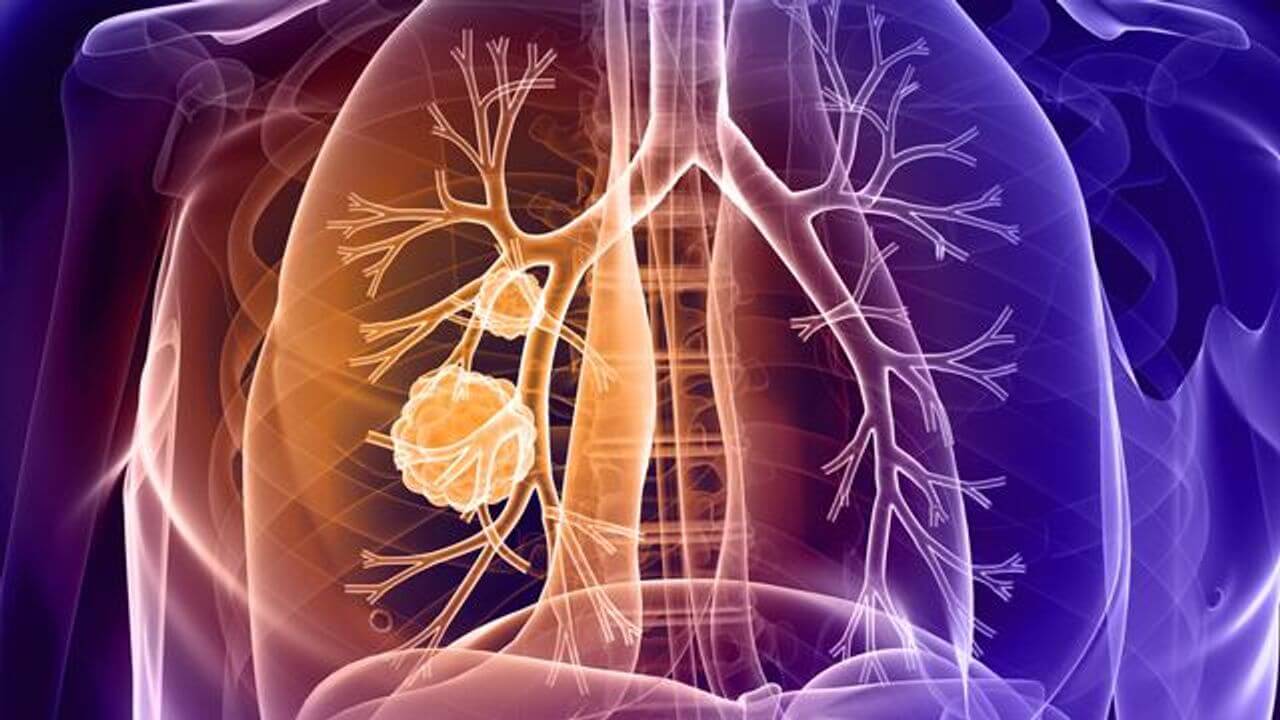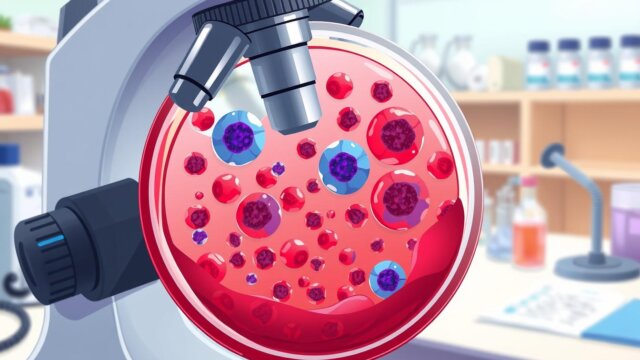FTC disclaimer: This post may contains affiliate links and we will be compensated if you click on a link and make a purchase.
Emphysema is a common, chronic lung disease and occurs as an advanced condition developing from other lung diseases, such as chronic bronchitis, bronchiectasis, and pneumonia.
These lung diseases progress to chronic obstructive lung disease with constricted airways and too much gas staying in the lungs. Therefore, Emphysema is formed.
In addition, smoking and genetic predisposition play a significant role as causes. Smokers often have an increased risk of developing Emphysema.
There are also work-related causes of Emphysema. For example, Emphysema is formed if workers have long-term exposure to dust, chemical substances, and high pressure.
Before Emphysema occurs, dust and chemical substances have initially concerned with bronchitis. These foreign matters, such as dust and chemical substances, are common risk factors for lung diseases.
That’s because the lung is sensitive to these stimuli and will become inflamed and structurally damaged. When gas is accumulated in the lungs, a high-pressure forms.
By the high gas pressure, the air sacs (medically, alveoli) will stretch until they burst – ultimately creating Emphysema or bullous Emphysema.
It is worth mentioning that asthma is also an obstructive lung disease when it attacks. Patients with a long-term history of recurrent asthma also have Emphysema as a complication.
Symptoms of Emphysema are mainly difficulty breathing and, particularly, making the sufferer difficult to exhale.
Other respiratory tract and cardiovascular symptoms may also occur, depending on the development of Emphysema, lung infection, existing bronchitis and secondary pneumonia, pulmonary hypertension, and pulmonary heart disease.
A physician can determine Emphysema by asking patients experiencing respiratory symptoms, chest X-rays/ CT scans, and lung capacity and function tests.
The treatment of Emphysema is targeted at alleviating emphysema symptoms, stopping the progression of the disease, and preventing complications.
For example, to avoid secondary pulmonary infection should be highly treated. In addition, quitting smoking and avoiding disease-causing substances are very effective preventive treatments and are often strongly recommended by every doctor.
For the purpose of prevention and treatment of Emphysema, the flu vaccine and pneumococcal vaccination also play an important role in secondary infections.
Let’s look in-depth at Emphysema’s causes, symptoms, diagnosis, and treatment.
What is Emphysema?
Emphysema is an irreversible lung disease that affects approximately three million Americans. Emphysema destroys lung tissue, hindering oxygen transport between the lungs and the blood.
The impairment of respiratory function by Emphysema causes breathing difficulties (dyspnea) and can lead to serious secondary health complications, including heart failure.
How Emphysema Affects the Respiratory System
Emphysema destroys the alveoli: tiny air sacs in the lungs that are essential for lung function.
As Emphysema progresses, the alveoli walls are destroyed, and larger, less elastic holes replace the small air sacs.
Expelling the air from these holes is difficult, as the damaged airways collapse during exhalation. Trapped, stale air accumulates in the lungs, causing the lungs to “hyper-inflate,” further reducing the supply of fresh oxygen.
Signs and Symptoms of Emphysema

Emphysema often occurs based on other chronic lung diseases, particularly chronic bronchitis.
When chronic bronchitis is complicated by Emphysema, based on the existing cough and sputum symptoms, the typical emphysema symptoms – breathing difficulties – gradually worsen.
Therefore, respiratory tract symptoms are mostly a shared result of Emphysema and chronic lung disease.
It can also be said emphysema symptoms are the further deterioration of those symptoms of chronic bronchitis.
However, there are still some patients who are suspected of having Emphysema through chest X-ray, but no detected chronic bronchitis. In these cases, they often have no emphysema symptoms in the early stage.
Dyspnea or Shortness of breath
Dyspnea, or Shortness of breath, is the most common symptom of Emphysema.
Dyspnea may not be apparent in the early stages of Emphysema because the disease progresses gradually. Dyspnea and other symptoms develop after the lung tissue has already been damaged.
Coughing
Coughing is another common emphysema symptom. The cough is not usually a wet, mucus-producing cough.
Wet coughs are a sign of bronchitis, a different type of lung disease. Wheezing, another common bronchitis symptom, is also absent in most cases of Emphysema.
Fatigue and weight loss
Fatigue and weight loss are common symptoms of Emphysema. As the disease progresses, some people develop a barrel-shaped chest.
Under normal circumstances, the chest is narrower from front to back than it is from side to side. Hyper-inflated lungs change the shape of the chest, expanding the sides of the chest.
Cough and sputum
Cough and coughing up phlegm are the common emphysema symptoms. The two symptoms of emphysema case due to inflammation and infection, which frequently coexist in pulmonary Emphysema.
Coughing up phlegm in the morning after waking up is typically in smokers. The sputum looks white and foamy.
If complicated by suppurative bacterial infection, the sputum appears yellow, sticky, and smells foul-smelling.
Difficulty breathing
Although cough and sputum often occur, the most prominent emphysema symptoms are breathing problems.
Depending on how severe the diseased changes are in the lungs, the patients may experience Shortness of breath only when they exercise, go upstairs, climb or do labor.
With the development of Emphysema, the emphysema symptoms can worsen. Patients can also suffer from Shortness of breath with no exertion at this stage. Difficulty breathing when lying down may begin to trouble them.
If an acute attack of bronchitis complicates Emphysema, the increased inflammatory secretions will block the small airways.
By this, lung ventilation will be further weakened; therefore, they feel increased Shortness of breath and chest tightness. Because of this, Emphysema symptoms develop further.
In the advanced stage, numerous alveoli and small airways are destroyed. Then, emphysema symptoms become severe; more emphysema symptoms emerge due to difficulty breathing and lack of oxygen.
The patients often have significantly reduced lung performance and very poor lung function.
They always feel breathless and may take pursed lips breathing. In severe Emphysema, respiratory failure may occur. That manifests itself as cyanosis, headache, drowsiness, and confusion.
Bluish Tinge
In some patients, a bluish tinge can be seen on the fingertips, lips, skin, and tongue. This bluish tinge, called cyanosis, indicates low oxygen levels in the blood and requires immediate medical treatment.
Emphysema patients may experience anxiety due to low oxygen levels and dyspnea. They may also experience swelling of the legs, ankles, and feet as the circulatory system becomes strained.
End-stage emphysema symptoms
In the end stage, the emphysema symptoms are worst. Respiratory failure and pulmonary heart disease with right heart failure will occur.
When patients suffer from these end-stage emphysema symptoms, they often have already been hospitalized:
- Weakness, fatigue, dizziness, heart palpitation.
- Cough, expectoration (typically, white foamy sputum), coughed up blood.
- Difficulty breathing and weak breathing;
- Cyanosis – bluish discoloration due to lack of oxygen in the blood, particularly in lips and nails;
- In pulmonary hypertension, a large blood volume remains in the venous vessels.
- Edema, pleural effusion;
- Respiratory failure also causes abnormal liver and kidney function – Some blood-related enzymes or biochemical substances rise.
- Stomach pain due to gastric mucosal damage, stress ulcer of the stomach, and the resulting bleeding.
- Lack of oxygen and excessive carbon dioxide will lead to neuropsychiatric problems, such as mania (abnormally elated mental state), coma, convulsions;
- Respiratory failure and heart failure also affect other organs. Therefore, they may cause symptoms in the liver (enlarged liver by liver congestion, cardiac cirrhosis, jaundice, and ascites), kidney (reduction in renal blood, diminished urine production), Gastrointestinal tracts (abdominal distension, loss of appetite, nausea or vomiting, caused by right heart failure).
Signs of Emphysema
A doctor can detect the signs of Emphysema during physical examination by palpation, percussion, visual examination, and auscultation. The meaningful signs include:
- Barrel-shaped chest, caused by inflated lungs;
- Decreased respiratory movement, felt by vocal fremitus/tactile fremitus;
- Distant heart sounds (due to inflated lungs), decreased breath sounds, prolonged expiratory phase (exhalation phase);
- Moist rale indicates lung infection or inflammation;
- Abnormal heart sounds location – An abnormal heart sound below the xiphoid (also called xiphoid process, small sword-shaped cartilage of the lower part of the sternum/breastbone); Here, the heart sounds stronger than the apex of the heart. (Suggesting a pulmonary heart disease).
Types of Emphysema (Based on Appearance)
According to the appearance of the patients, Emphysema can be divided into “pink puffer” and “blue bloater,” which are possible between the two types of smooth transitions.
“Pink Puffer,” the emphysema type (A type)
Patients are mostly rather skinny. They suffer from respiratory distress with low oxygen but no cyanosis. That’s because hyperventilation maintains normal blood carbon dioxide/oxygen levels by strong, deep breathing.
So they gasp frequently and continuously. Cough and expectoration are not serious, Or only a dry, irritating cough.
A barrel-shaped chest sign is typically seen in skinny elderly patients. The emphysema signs are prominent showed in a chest X-ray image.
And the heart becomes long and narrow and develops in a vertical position. In the advanced stage of Emphysema, Respiratory failure and pulmonary heart disease with right heart failure will occur until the advanced stage.
“Blue Bloater”: the bronchitis type (B type)
Patients are mostly rather overweight in middle old people. They have cyanosis, typically with the blue/purple discolored lips and nails caused by a decreased oxygen saturation.
Shortness of breath is less; Productive cough is severe and frequent; Copious, foul-smelling sputum production results from secondary pneumonia or purulent infection.
Under the chest radiograph, the lungs’ signs of emphysema are not obvious. In bronchitis-type Emphysema, respiratory tract infections are frequent and recurrent.
With this infection, patients often get respiratory and right heart failure – enlarged heart shadow showed in chest X-ray or scanned by color doppler ultrasound.
Emphysema Health Complications
As lung function deteriorates, other health complications may develop. Respiratory disease and lung infections occur with greater frequency. Other possible health complications include:
Wet Cough: Emphysema usually presents with a dry cough. A wet, mucus-producing cough may indicate pneumonia or a lung infection.
Heart Complications: Blood flow through the lungs is negatively affected by Emphysema and places the heart under increased strain. In time, heart failure may develop.
Lung Cancer: While lung cancer is not an actual health complication of Emphysema, most emphysema sufferers are smokers, which increases their risk of lung cancer.
Understanding the Causes and Risk Factors for Emphysema

Emphysema is irreversible lung hyperinflation, characterized by an expansion and burst of the lungs’ air spaces (alveolus).
In severe regions, numerous broken alveoli form one or several bullae – larger bubble cavities from 1 cm to more than 10 cm in size or even occupying the entire side of the lung.
Pulmonary Emphysema (including bullous Emphysema) is very common, especially in old people, smokers, and some high-risk occupational groups. Many risks and causes can cause or promote the formation of Emphysema.
Emphysema and smoking
Various factors that can cause chronic bronchitis, such as infection, smoking, air pollution, occupational dust, long-term exposure to harmful gases, and allergic factors, lead to Emphysema.
The most common cause of Emphysema is smoking, by which some substances in cigarette smoke can inflame and destroy the respiratory tracts and promote your body to produce too much elastase.
The elastase can break down the elastic fibers of respiratory tracts, making the small airways so relaxed that they lose contraction strength.
As a result, the gas remains in the lungs and can not be exhaled easily. Smokers’ respiratory tracts are susceptible to inflammation and infection from bacteria, viruses, allergies, and other substances.
Lung diseases and Emphysema
Before Emphysema is formed, the patients often suffer from chronic bronchitis. And the two lung diseases are often diagnosed together with pulmonary heart disease.
Chronic bronchitis-emphysema-pulmonary heart disease is a common diagnosis in elderly patients with advanced lung disease.
Chronic bronchitis and many other diseases can also develop Emphysema if they worsen, for example, bronchiectasis, pulmonary tuberculosis, asthma, chronic pneumonia, and pulmonary fibrosis.
Occupationally environmental factors
Occupational factors are also responsible for pulmonary Emphysema. For example, we often find emphysema signs by chest X-ray or CT images in workers with silicosis.
They are always exposed to dust or chemical substances. Fine dust is present in coal mines, silicon mines, quarries, or some factories in which air is mixed with asbestos, rubber dust, and organic dust such as animal feed and raw cotton.
Some metal manufacturers may also have some of the metal powders.
High pressure
High pressure can lead to overexpansion of the alveoli, thus to pulmonary Emphysema or its advanced type – bullous Emphysema.
This can be seen in professional musicians. A sudden large laughing may sometimes tear the bulla of the lung and induce a pneumothorax. At this point, you suddenly felt severe chest pain.
The Roles of Proteolytic Enzymes and Cigarette Smoking
Emphysema causes permanent damage to the lungs. As lung tissue is destroyed, the surface area of the lungs is reduced, and the ability to transport oxygen between the lungs and the blood is seriously compromised.
The direct cause of this damage appears to be a family of proteins referred to as proteolytic enzymes.
Proteolytic Enzymes and the Lungs
Proteolytic enzymes are highly specialized proteins. The primary function of proteolytic enzymes is to break down other proteins. Tissue destruction occurs when proteolytic enzymes are unusually active.
Proteolytic enzyme activity is usually controlled by Antiproteolytic substances, which prevent the proteolytic enzymes from causing abnormal tissue damage.
Studies of emphysema patients have revealed that the disease is usually associated with one of two imbalances.
Either proteolytic enzymes function at high activity levels, or the body lacks Antiproteolytic substances.
Cigarette Smoking
The chief cause of Emphysema is cigarette smoking. Cigarette smoking irritates the lungs and has been linked to heightened activity of proteolytic enzymes.
Cigarette smoking also increases the chances of chronic bronchitis, which often coexists with Emphysema.
Cigarette smoking affects the health of more than just smokers. Exposure to secondhand cigarette smoke has been proven to increase the risk of Emphysema in nonsmokers.
Inherited Emphysema
Inherited forms of Emphysema are rare and most often seen in people of northern European descent.
Those who inherit emphysema lack alpha-1 antitrypsin, a protein that blocks the action of proteolytic enzymes and is usually present in the lungs.
Alpha-1 antitrypsin deficiencies are caused by a liver disorder that can cause cirrhosis.
Other Risk Factors
Occupational toxins and environmental air pollution have also been linked to Emphysema, although cigarette smoking still accounts for the vast majority of cases.
Other diseases of the lungs, including bronchial asthma, also increase the risk of Emphysema.
Men have a forty percent higher incidence rate than women; however, the number of women developing Emphysema is rising as a wave of long-term female smokers is approaching middle age.
The risk of Emphysema also increases with age, mostly because it takes years before damage to the lungs becomes apparent.
Tools and Tests Used to Diagnose Emphysema
A medical diagnosis of Emphysema requires a physical exam of the lungs. Chest x-rays are commonly used to make medical diagnoses.
CT scans of the lungs and blood tests may also be required for a firm diagnosis of Emphysema.
The Physical Exam: Testing the Lungs
The medical diagnosis starts with a physical exam of the lungs. The doctor will use a stethoscope to listen to the lungs.
Emphysema does not produce the wheezing characteristic of bronchitis. Instead, lung sounds are faint and diminished.
Emphysema may produce a “barrel chest” as the lungs hyper-inflate and change shape. This sign is most likely to be noticed in advanced cases of Emphysema.
Auscultation
By listening to the lungs, we can hear a buzzing noise for wheezing, weakened breath sound, prolonged expiratory sound, and moist rales (bubble sound) for a secondary lung infection.
Percussion
Tapping/knocking on the chest, they can hear a loud, hollow-sounding acoustic sound. Through this sound (medically, hyperresonance= excessive resonance for pulmonary Emphysema, or even tympany= a hollow drum-like sound for lung bullae, pneumothorax).
Moreover, they can knock out the vague range of the lung to determine the extent of lung expansion.
Inspection (visual examination)
They often observe the patient’s appearance and breathing behaviors by observing their eyes.
Blue-stained lips and nails (cyanosis) often indicate a lack of oxygen, usually due to Emphysema.
A barrel-shaped chest tells us patients’ lungs with hyperinflation. Abnormal breathing behaviors suggest that patients are breathing characterized by strongly-deep or rapid-shallow-short breathing due to respiratory difficulties.
Spirometry
A spirometry test will be ordered if the physical exam results warrant further investigation. During spirometry, you breathe into a tube attached to a machine (spirometer) that measures lung function.
Spirometry determines the volume of the lungs and how quickly air can be expelled from the lungs.
The results of spirometry, combined with the physical exam, provide information about lung function that helps make a medical diagnosis.
Chest X-rays and Emphysema

After the physical exam, most doctors will order a chest x-ray. A chest x-ray rules out several other complications, including the possibility of lung cancer or pneumonia.
A chest x-ray may also reveal the presence of over-inflated lungs, a common sign of Emphysema. Many doctors consider a chest x-ray the most helpful test during a medical diagnosis.
They can detect diseased changes by the X-ray image, which can suggest Emphysema and facilitate the diagnosis by the following signs:
- Excessive gas shows “blacker” in the lung X-ray image (i.e., X-ray transparency of lungs is increased due to excessive air in the lungs).
- Horizontal extending ribs;
- Widened intercostal spaces;
- A depressed or flattened diaphragm, the low position of the diaphragm;
- Collapsed outer edge of the lung;
CT Scans and Blood Tests

If further testing is required after the chest x-ray and physical exam, a CT scan may be ordered to provide a more detailed x-ray of the lungs.
A high-resolution computed tomography (HRCT scan) can accurately assess the location and range of Emphysema and the degree of lung damage, complementing the emphysema diagnosis.
It is particularly meaningful if our doctors intend to take the surgical resection and repair.
Blood tests may be required during the medical diagnosis of Emphysema. High levels of white blood cells may indicate an infection of the lungs.
Advanced stage emphysema may require an arterial blood gas test. This test measures the amount of oxygen and carbon dioxide in the blood. Low levels of oxygen may require treatment with an oxygen mask.
Treatment of Emphysema
Lung damage caused by Emphysema cannot be reversed. Emphysema treatment concentrates on halting the progression of Emphysema and controlling the symptoms.
Quit Smoking
Emphysema patients who smoke should quit as soon as possible. Quitting smoking will restore some lung function and can sometimes halt the progression of Emphysema.
Lung Surgery
Some authorities question the effectiveness of lung surgery as an emphysema treatment.
Proponents of lung surgery claim that surgical removal of abnormal lung tissue can improve lung elasticity and make breathing easier for patients.
Lung surgery is not an option for all patients. Two different forms of lung surgery are available for those who meet the criteria: bullectomy and lung volume reduction surgery.
Bullectomy
Bulla is large air sacs in the lungs caused by emphysema damage. Although they are filled with air, bulla does not aid in breathing. Instead, they take up space in the lungs and contain stale, “dead” air.
A bullectomy removes the bulla from the lungs. A bullectomy aims to free up lung space by allowing healthy air sacs to expand into the empty space once occupied by the bulla.
This lets healthy air sacs process more oxygen. Clinical investigation of bullectomy procedures is ongoing as researchers try to determine the effectiveness of this type of lung surgery.
Lung Volume Reduction Surgery
Like a bullectomy, lung volume reduction surgery removes damaged lung tissue from a patient’s lungs. However, lung surgery removes much larger portions of lung tissue.
Removal of damaged lung tissue improves the elasticity of the lungs, which may improve lung function.
Nutrition and Emphysema Patients
Emphysema patients are often underweight. Patients with advanced emphysema tire easily and have weakened muscles.
Adequate nutrition is essential to maintain activity levels, perform daily tasks, and facilitate breathing.
Alpha-1 Antitrypsin Replacement Therapy
Clinical trials are investigating the possibility that alpha-1 antitrypsin replacement may help patients with Emphysema.
This possibility is of special interest for patients with inherited alpha-1 antitrypsin deficiencies. Clinical trials are investigating the most effective delivery methods for alpha-1 antitrypsin.
Treatment Strategies for COPD Patients
Emphysema patients suffering from chronic bronchitis have COPD or chronic obstructive pulmonary disease.
COPD cannot be cured, but the progress of the disease can be slowed with treatment. Patients may benefit from the following COPD treatment strategies:
- Annual flu shots
- Breathing exercises
- Bronchodilators
- Pneumonia vaccination
- Lung transplant
- Quitting smoking
- Supplemental oxygen masks.
Outlook
Emphysema is a serious lung condition caused by smoking, exposure to secondhand smoke, or air pollution. Symptoms include Shortness of breath, coughing, and difficulty breathing.
If you think you may have Emphysema, see your doctor for a diagnosis. There is no cure for Emphysema, but treatments are available to help relieve symptoms and slow disease progression.








